Can art endow ephemera with form? Can it subtract matter from substance?
At first, these questions might seem no more than delicious whimsy. Even so, they probe the essence of "The Ambiguous Lightness of Being—An Homage to Milan Kundera" at Diana Lowenstein Gallery in Miami's Wynwood Arts District.
In this alluring, occasionally vexing exhibit, curator Ombretta Agró Andruff has put together 28 works by 12 artists from the Americas and Europe, produced between 2005 and 2015. There's such a striking range of media that the exhibit, with its delicate beauty, briefly recalls rainbow shadows created by glass prisms dangling in sunlight streaming through a window.
Taken together, the artworks reveal glistening, ever-evolving facets of Andruff's curatorial concept. She's chosen art that provokes viewers to contemplate its substantial heaviness, possibly evoking a kind of moral certitude. But she has also incorporated art, by nature of its material presence, that's fabulously lightweight, possibly evoking ecstatic freedom, both physical and spiritual.
This curious contrast between lightness and weight becomes the guiding focus of her exhibit at Diana Lowenstein Gallery. And that focus is inspired by Milan Kundera's famed 1984 novel “The Unbearable Lightness of Being.”
In her catalog essay, the curator quotes Kundera's novel: "The heaviest of burdens is therefore simultaneously an image of life's most intense fulfillment. The heavier the burden, the closer our lives come to the earth, the more real and truthful they become. Conversely, the absolute absence of burden causes man to be lighter than air, to soar into heights, take leave of the earth and his earthly being, and become only half real, his movements as free as they are insignificant. What then shall we choose? Weight or lightness?"
An intriguing concept, to be sure. At times, verging on the precious. Upon reflection, almost unbearably timely.
Kundera's novel recounts the stories of lovers around the time of Czechoslovakia's all-too-brief Prague Spring of 1968, celebrated now as an ill-fated, grassroots movement advocating for human rights and individual freedom in a country that had become a Communist dictatorship after World War II.
During the Prague Spring, there was a flowering of Czech artistic and intellectual life, which a Soviet-led invasion eventually quashed, causing Kundera and other artists to emigrate. Totalitarian oppression triumphed, not to be defeated until much later.
While Andruff writes in the catalog essay that she began thinking about curating an exhibit like this as early as 2002, this particular show was sparked by her meetings in the last two years with artists in Eastern and Central Europe as well as Cuba.
The international range of artists in this exhibit explores the vagaries of fragile, transient beauty in a way that parallels today's daily headlines. Certainly we are living at a time when there's much global anxiety. Seas are rising. Rogue storms wreak havoc. International borders are besieged as a result of political turmoil in Europe and the Mideast. Democratic institutions and values, in the United States and abroad, are threatened in the wake of widening income gaps. The politics of fear become rampant.
So it is that themes of vulnerability and impending loss resonate now with an urgent force. Artists in this exhibition find vivid materials to evoke such ideas.
Weighty materials of lead and bricks inform work by Jaroslav Kysa. Monument for Fallen Monuments is the ultimate anti-monument. It's either a surreal joke or a sly critique of arrogant political powers that have for centuries demanded the building of monuments, which invariably topple later as regimes and leaders change. This kinetic sculpture looks like a tiny, eyeball shaped surveillance device, with mysterious revolving parts crafted from iron dust and Perspex.
Less fastidious and more direct is Kysa's Brick. This brick appears to float in space, yet as an installation it is deceptively engineered to be as stable as the Washington Monument. The piece is infused with sly wit and, indeed, a kind of gallows humor.
As the artist explained to the curator about Brick: "It refers to throwing bricks at the demonstrations, it symbolizes the growing trend of the protest in the time of crisis of democracy all over the world, but it does not offer any alternative. That's why the brick is just aimlessly hovering in space."
Ronald Moran mines the metaphorical power of bricks in a way that seems tailor-made for this exhibit. His Muro sin sombras (Wall Without Shadows) also appears to float in space. Installed in a corner of the gallery, it's an exquisitely crafted three-dimensional drawing in white thread of a brick wall.
.
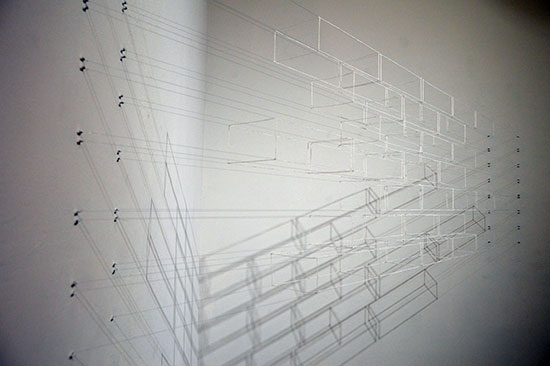
"Muro sin sombras" by Ronald Morán, 2016. White thread, dimensions variable.
.
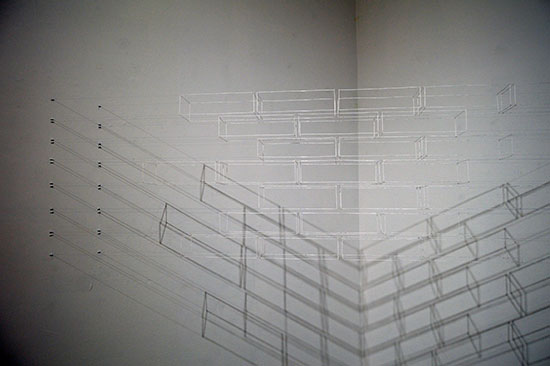
"Muro sin sombras" by Ronald Morán, 2016. White thread, dimensions variable.
.
Another work paradoxically riffs on the imposing strength of a wall by employing thread and other textiles. This is the absolutely stunning Untitled - Installation by Marisabela Telleria, composed of several abstract canvases, vertical strips of clear tape, threads, and iridescent tulle fabric.
Attached to a white gallery wall, these elements weave together a composition of musical complexity. Abstract rectangular patterns shimmer, moving forward and receding in space, challenging perceptions of depth and volume. Its beauty is breathtaking, evolving in shape and color second by second as viewers approach Telleria's work from various angles.
.
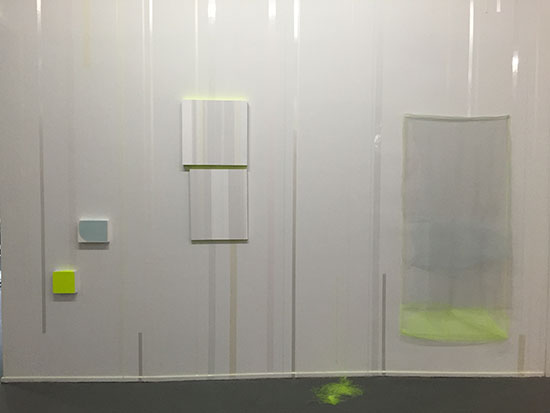
"Untitled - Installation" by Marisabela Telleria, 2016. Mixed media, dimensions variable.
.
The deceptive nature of how we perceive the relative volume and substance of objects—or, by extension, the world around us—is evoked in Globos by Xawery Wolski, a disarmingly simple and elegant piece. Dozens of hollow globes about the size of a fist are each intricately made from copper wire woven around a balloon; when the balloon is popped the miniature wire globe remains intact.
The globes are installed in overlapping clusters so that their delicacy multiplies, morphing into strong metaphorical statements. They evoke teeming molecular life in a drop of water, say, or heavenly bodies in the Milky Way.
.
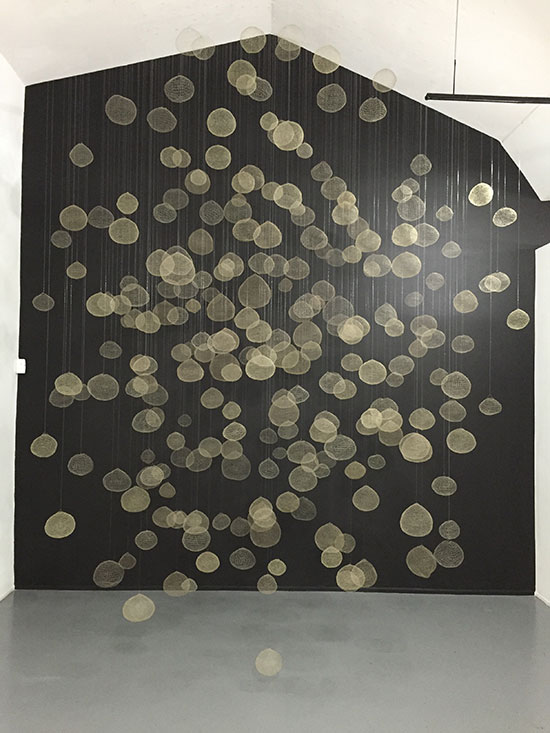
"Globos" by Xawery Wolski, 2010. Copper wire, dimensions variable.
.
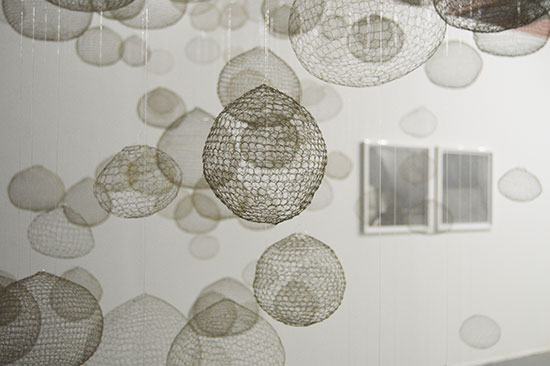
Detail of "Globos" by Xawery Wolski, 2010. Copper wire, dimensions variable.
.
Still more visual sleights of hand: Michele Chiossi, acknowledging the influences of Lucio Fontana and Alighiero Boetti, brings together in Carrara Arabesque the soft glow of pink neon with precisely chiseled forms of white Carrara marble. In this lustrous combination, geometric skeins of marble appear to float on the wall, their weighty volume contrasting mightily with a surrounding pink haze.
Loris Cecchini, with his Wall Wave Vibrations (A Synchronous Emotion), similarly exults in challenging perceptions regarding what is solid and impenetrable by creating white surfaces on the wall that pulsate in subtle, barely-there waves.
.
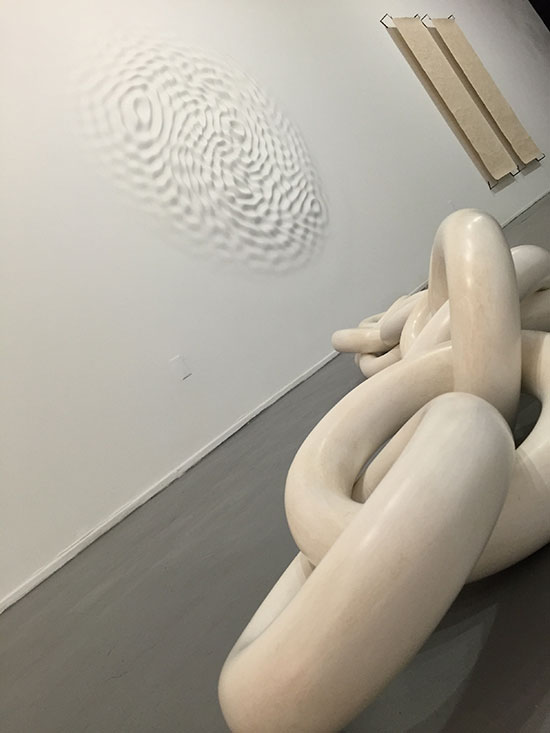
"Wallwave Vibrations (Asynchronous emotion)" by Loris Cecchini, 2012. Polyester resin, wall paint.
.
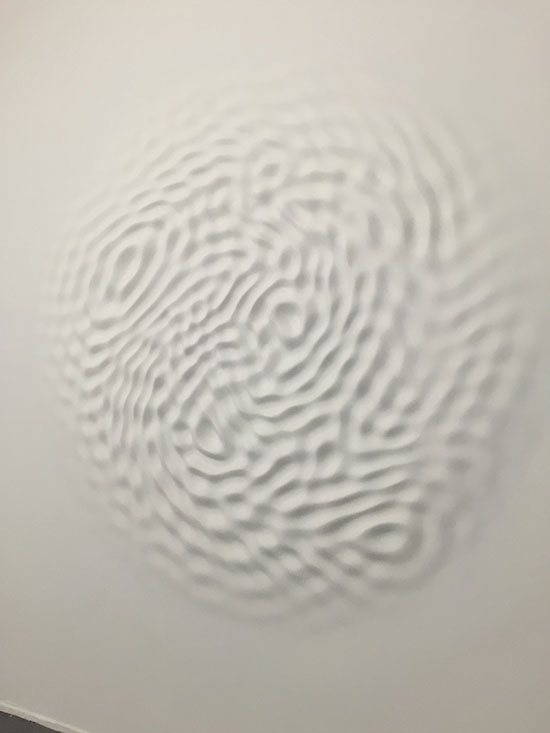
"Wallwave Vibrations (Asynchronous emotion)" by Loris Cecchini, 2012. Polyester resin, wall paint.
.
Artists in this show have made ingenious use of materials to skewer what might be called viewers’ "visual comfort zones." This is a common occurrence even in the ever more experimental 21st century, when significant geopolitical eruptions occur across the map.
By creating striking images of fleeting beauty, the artists seem to bear witness to a period of swiftly evolving social and political change. Intentionally or not, much work in this show taps into the current sense of anxiety and dislocation.
____________________________
BASIC FACTS: "The Ambiguous Lightness of Being—An Homage to Milan Kundera" is on view through March 31, 2016 at Diana Lowenstein Gallery, 2043 North Miami Avenue, Miami FL 33127. www.dianalowensteingallery.com; 305-576-1805.
_____________________________
Copyright 2016 Hamptons Art Hub LLC. All rights reserved.
